A Train to Rockaways: 4-Month Shutdown Guide
A significant subway improvement project is on the horizon, impacting A train service along the Rockaway line for four months. The purpose of this shutdown is to address lingering damage from Superstorm Sandy and fortify the infrastructure to withstand potential future storms. The Metropolitan Transportation Authority (MTA) has announced that the service suspension will commence on Friday evening and continue until May. During this period, there will be no A train service between Howard Beach-JFK Airport and Far Rockaway-Mott Avenue or Rockaway Park-Beach 116 Street.
Impact on Riders and Alternative Services
In addition to the A train disruption, the Rockaway Park Shuttle will also be affected. Commuters will not have access to shuttle service to or from Broad Channel, and the shuttle trains will not operate at all during the first weekend of the shutdown (Jan. 17-20). The MTA has provided detailed information on the full extent of service disruptions for riders to review.
MTA Chair and CEO Janno Lieber emphasized the necessity of making the A train more dependable and resilient for Rockaway passengers. Lieber expressed confidence in the New York City Transit team’s ability to offer rapid and frequent alternative services during the construction phase, drawing a parallel to the successful G train service provided during the summer shutdown.
Alternative Transportation Options
To mitigate the inconvenience caused by the service suspension, the MTA has arranged for free shuttle bus services. The Q97 will operate between Howard Beach and Far Rockaway, while the Q109 will run from Howard Beach to Beach 67 Street. Furthermore, Rockaway residents can avail themselves of discounted Long Island Rail Road (LIRR) fares at $2.75 each way by purchasing tickets at the LIRR Far Rockaway Station.
Importance of Rehabilitation Work
While the temporary closure of A train service may pose challenges for commuters, the rehabilitation work on the Rockaway Line is deemed essential by the MTA. The infrastructure upgrades are necessary to address the lasting damage caused by Superstorm Sandy and to ensure the safety and reliability of transit operations for the approximately 9,000 daily riders. According to the MTA, critical enhancements to the viaducts and bridges supporting the train line across Broad Channel are imperative to protect against future storm-related disruptions.
As we navigate this period of service interruption, it is vital to recognize the long-term benefits that these infrastructure improvements will bring to the Rockaways community. The MTA’s commitment to enhancing transportation infrastructure underscores the importance of investing in resilient and sustainable public transit systems for the future. While adjustments to travel routines may be required in the short term, the ultimate goal is to create a more robust and efficient transit network that can withstand the challenges posed by natural disasters and climate change.












